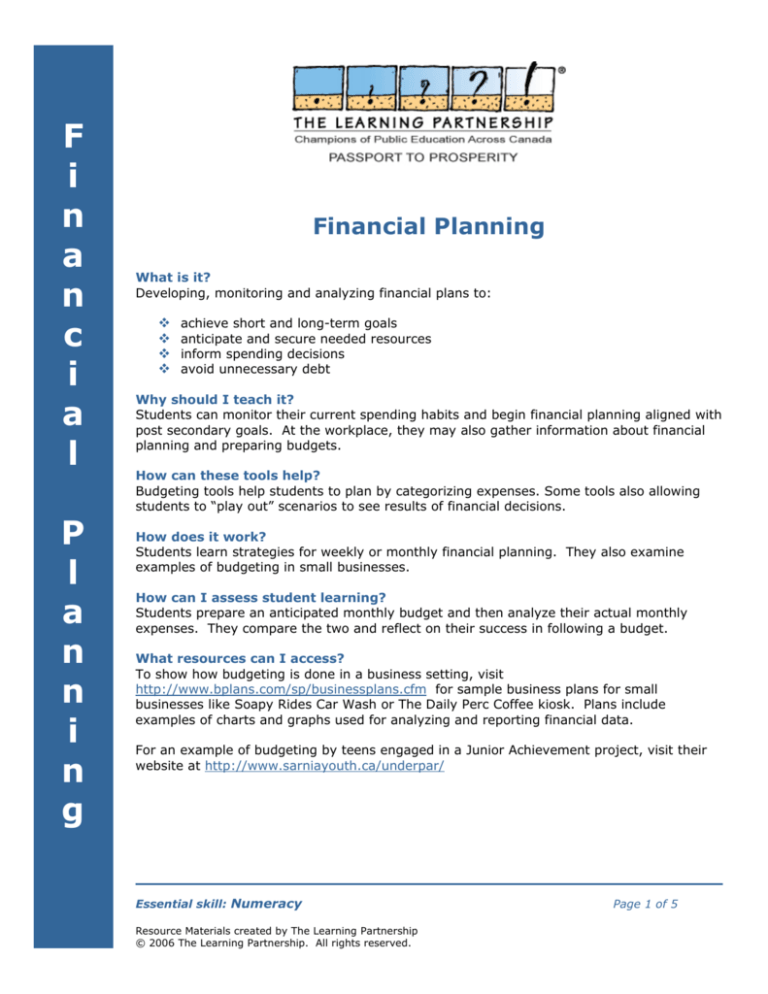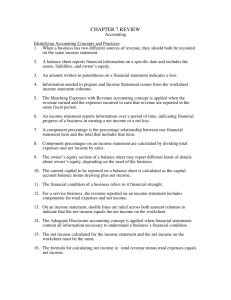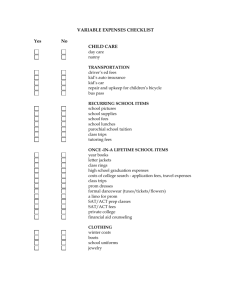
F
i
n
a
n
c
i
a
l
P
l
a
n
n
i
n
g
Financial Planning
What is it?
Developing, monitoring and analyzing financial plans to:
achieve short and long-term goals
anticipate and secure needed resources
inform spending decisions
avoid unnecessary debt
Why should I teach it?
Students can monitor their current spending habits and begin financial planning aligned with
post secondary goals. At the workplace, they may also gather information about financial
planning and preparing budgets.
How can these tools help?
Budgeting tools help students to plan by categorizing expenses. Some tools also allowing
students to “play out” scenarios to see results of financial decisions.
How does it work?
Students learn strategies for weekly or monthly financial planning. They also examine
examples of budgeting in small businesses.
How can I assess student learning?
Students prepare an anticipated monthly budget and then analyze their actual monthly
expenses. They compare the two and reflect on their success in following a budget.
What resources can I access?
To show how budgeting is done in a business setting, visit
http://www.bplans.com/sp/businessplans.cfm for sample business plans for small
businesses like Soapy Rides Car Wash or The Daily Perc Coffee kiosk. Plans include
examples of charts and graphs used for analyzing and reporting financial data.
For an example of budgeting by teens engaged in a Junior Achievement project, visit their
website at http://www.sarniayouth.ca/underpar/
Essential skill: Numeracy
Resource Materials created by The Learning Partnership
© 2006 The Learning Partnership. All rights reserved.
Page 1 of 5
Sample Lesson:
F
i
n
a
n
c
i
a
l
P
l
a
n
n
i
n
g
Financial Planning
Introduction: Group Brainstorming
1. Ask, What strategies are you currently using to keep track of
a) how much income or money you have?
b) how you spend your income or money?
2. Chart the class responses on 2 charts “Tracking Income” and “Tracking Expenses”
3. Once the class has generated the 2 lists, give each student a marker or several coloured
dots and ask them to indicate which methods they currently use. This will indicate the
frequency of budget methods currently being used.
4. Then ask, “What might be the benefits of having a system for managing finances?”
This website lists 12 reasons to budget:
http://financialplan.about.com/cs/budgeting/a/12ReasonsBudget.htm
Looking at the Current State
1. Distribute copy of the worksheet : Your Current Financial State
2. Students will record expenses daily for the next month.
3. At the end of the month, they will compare total monthly income and total monthly
expenses to determine their current state: monthly surplus or monthly deficit.
Dealing with a Financial Deficit
1. At the end of the month, poll the class anonymously to determine
a) how many students have a surplus
b) how many students have a deficit
Give each student a blank card and have them write “Surplus” or “Deficit”.
Ask them to drop the cards in a box or bag and then tally the results for the class.
2. Review the suggestion at the end of the worksheet to eliminate or reduce expenses in
some areas.
3. Organize students into groups of 4. Ask each group to brainstorm ideas for ways to
reduce expenses, especially for items that are “wants” rather than “needs”.
For example: Postpone clothing purchases to take advantage of sales
Consider bringing a lunch to school or work
4. Post their lists and invite students to continue adding ideas to the charts as they think of
or learn about other budget tips.
Essential skill: Numeracy
Resource Materials created by The Learning Partnership
© 2006 The Learning Partnership. All rights reserved.
Page 2 of 5
Introduce “The Latte Factor”
F
i
n
a
n
c
i
a
l
David Bach, author of books like The Automatic Millionaire. uses this term to describe items
that we buy, often every day, without thinking about how they add up over time. He often
tells the story of a woman who complained to him at one of his seminars that she couldn’t
save any money. However, when he talked to her about her daily spending habits, she
realized that she was spending almost $5.00 every day on a latte.
On his website, http://finishrich.com, Bach calculates the saving potential of bringing coffee
from home rather than buying a $5 latte:
$35/week = $150/month
$150 per month invested at a rate of 10% annual return =
1 year = $1,885
2 years = $3,967
5 years = $11,616
10 years = $30,727
15 years = $62,171
30 years = $339,073
40 years = $948,611
For many teens, buying cigarettes would be an example of their “latte factor.”
Preparing (and Living Within) a Monthly Budget
P
l
a
n
n
i
n
g
1. Distribute 2 copies of the worksheet: Budget Planning
2. Ask students to list major expense categories from last month’s daily lists.
(Some categories might be: transportation, clothing, entertainment, meals outside
home, activity fees, rent or housing costs, gifts, etc.)
3. They will determine if these categories are
a) fixed expenses: commitments that must be paid on schedule (e.g. car loan)
b) variable expenses: costs which can fluctuate depending on funds available (e.g. gifts)
c) examples of the “Latte factor” – luxuries which if eliminated could result in savings
4. After determining their available income, students will assign funds to each of the
categories on the first copy of the budget planning sheet.
5. Students will continue to record daily expenses for the month.
6. Using these daily expense records, students will complete the second copy of the budget
planning sheet, listing actual expenses for the month.
7. At the end of the unit, students will submit both their planned and actual budget sheets
along with their responses to the questions on the worksheet: Reflections on my Budget
Process.
Essential skill: Numeracy
Resource Materials created by The Learning Partnership
© 2006 The Learning Partnership. All rights reserved.
Page 3 of 5
Extensions to the Lesson:
F
i
n
a
n
c
i
a
l
P
l
a
n
n
i
n
g
1. When students visit the workplace, invite them to collect samples of department or
project budgets.
2. Explore other websites that have budget tools to help families manage their financial
planning like:
http://www.betterbudgeting.com/freeworksheets/monthlyspending.htm
Worksheet: Reflections on my Budget Process
1. How accurate were your estimates of monthly expenses?
2. How did you monitor or adjust your spending during the month?
3. What changes have you noticed in your spending from the previous month?
4. What have you learned from this process that would help you with future
financial planning?
5. What new questions do you have about financial planning?
Essential skill: Numeracy
Resource Materials created by The Learning Partnership
© 2006 The Learning Partnership. All rights reserved.
Page 4 of 5
Worksheet: Budget Planning
F
i
n
a
n
c
i
a
l
P
l
a
n
n
i
n
g
Instructions:
Column 1
Column 2
Column 3
Column 4
List all sources of income
Indicate monthly income
List categories of expenses identified from daily lists
Separate these into:
Fixed Expenses, Variable Expenses and “Latte Factor: Items
Fill in monthly totals for each category
Total Income and Expenses at the bottom of Columns 2 and 4
1
Income
Sources
2
Monthly
Amount
3
Monthly
Fixed
Expenses:
4
Monthly
Amount
Allowance
Salary
Interest on
savings
Gifts
Other
Monthly
Variable
Expenses
“Latte
Factor”
Items
Total:
Essential skill: Numeracy
Resource Materials created by The Learning Partnership
© 2006 The Learning Partnership. All rights reserved.
Total:
Page 5 of 5







